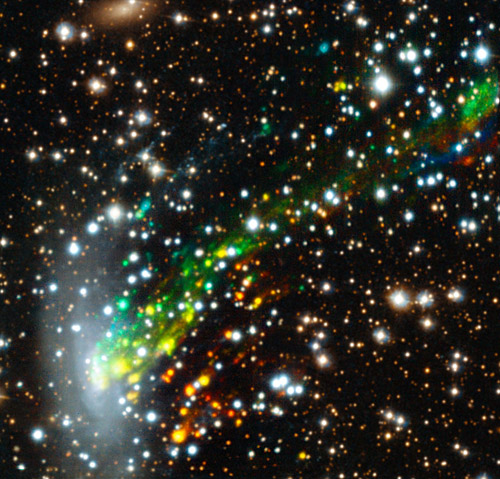Das neue Instrument MUSE am Very Large Telescope (VLT) der ESO hat Forschern die bislang beste Aufnahme eines spektakulären kosmischen Zusammenstoßes geliefert. Die neuen Beobachtungen zeigen zum ersten Mal die Bewegung des Gases, während es aus der Galaxie ESO 137-001 herausgerissen wird und mit Höchstgeschwindigkeit in einen riesigen Galaxienhaufen stürzt. Die Ergebnisse sind der Schlüssel zur Lösung eines alten Rätsels – der Frage warum die Sternentstehung in Galaxienhaufen abgeschaltet wird. In diesem Bild zeigen die Farben die Bewegung der Gasfilamente an – rot bedeutet, dass sich das Material von der Erde weg bewegt, blau dagegen bedeutet eine Bewegung auf die Erde zu. Der obere linke und der untere rechte Teil des Bildes wurden durch Hubble-Aufnahmen des Objektes ergänzt. Image credit: ESO/M. Fumagalli
The MUSE instrument on ESO’s Very Large Telescope has provided researchers with the best view yet of a spectacular cosmic crash. Observations reveal for the first time the motion of gas as it is ripped out of the galaxy ESO 137-001 as it ploughs at high speed into a vast galaxy cluster. The results are the key to the solution of a long-standing mystery — why star formation switches off in galaxy clusters. In this picture the colours show the motions of the gas filaments — red means the material is moving away from Earth compared to the galaxy and blue that it is approaching. Note that the upper-left and lower-right parts of this picture have been filled in using the Hubble image of this object.
(Visited 29 times, 1 visits today)

